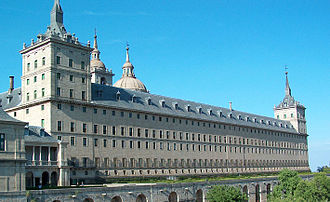Herrera style

Herrera style ( Spanish : Estilo Herreriano , Herrerianismo or also called Desornamentado style ) is the name for a Spanish architectural style of the late renaissance in the time of the Counter Reformation (approx. 1560-1620). It is named after the master builder Juan de Herrera , who between 1572 and 1584 directed the construction work on the extremely strict palace and monastery complex of the Escorial , which was co-designed by Philip II .
Characteristics
The Herrerianismo is a strict and ornamentless style, in which the architecture of the mendicant orders ( Franciscans , Dominicans ) could have been the godfather. The structure and the outer and inner walls are largely free of curvilinear lines; Horizontal cornices , vertical wall supports such as pilaster strips and pilasters or the highlighting of individual components with central or corner projections are largely avoided. Even windows and doors are often not framed, or only framed extremely cautiously - they look like they have been cut into the wall; there are also no balconies or balustrades . However, this extreme conception of style has only been strictly adhered to in a few buildings (e.g. the Escorial or the Palacio Ducal de Lerma ); elsewhere, individual structural elements appear, but overall the style - in clear contrast to the previous, sometimes even simultaneous Plateresque style (plateresco) - remains largely ornament-free and unadorned. Architects and architectural historians also speak of a “pure style”.
Most important architects
- precursor
- Rodrigo Gil de Hontañón (1500–1577)
- Juan Bautista de Toledo (around 1510–1567)
- Alonso de Covarrubias (1488-1570)
- Main representative
- Juan de Herrera (1533–1597)
- Francisco de Mora (1553-1610)
- successor
- Juan Gómez de Mora (1586–1648)
- Ventura Rodríguez (1717–1785)
buildings

- Predecessor of the Herrera style
- Ducal Palace of Berlanga de Duero (early 16th century)
- West side of the Church of San Sebastián in Villacastín (around 1535/40)
- Alcázar of Toledo (around 1535, subsequently restored several times)
- Façade of the Iglesia Santiago Apóstol in Cigales (around 1535)
- Hospital de Tavera in Toledo (1541–1603)
- Ducal Palace in Pastrana (construction started around 1545)
- Herrera style
- Escorial (1563–1597)
- Church of the Uclés Monastery (1580? –1598)
- Nuestra Señora de la Asunción Church in Valdemorillo (16th century)
- Santiago Apóstol Church in Cebreros (16th century)
- Ducal Palace of Lerma (1601–1617)
- Casa de la Panadería in the Plaza Mayor in Madrid (1617-1619)
- Palacio de Santa Cruz , Madrid (1629–1637)
- Ducal Palace of Medinaceli in Medinaceli (1621 – around 1650)
- successor
- Residential wing of the monastery of San Isidro de Dueñas , Province of Palencia (17th century)
- Palacio de Goyeneche , Nuevo Baztán , around 1713
- Convento de San Agustín , Haro (1741)
- Palacio del Infante don Luis , Boadilla del Monte (1761–1765)
- Palacio de la Mosquera , Arenas de San Pedro (1776–1783)


